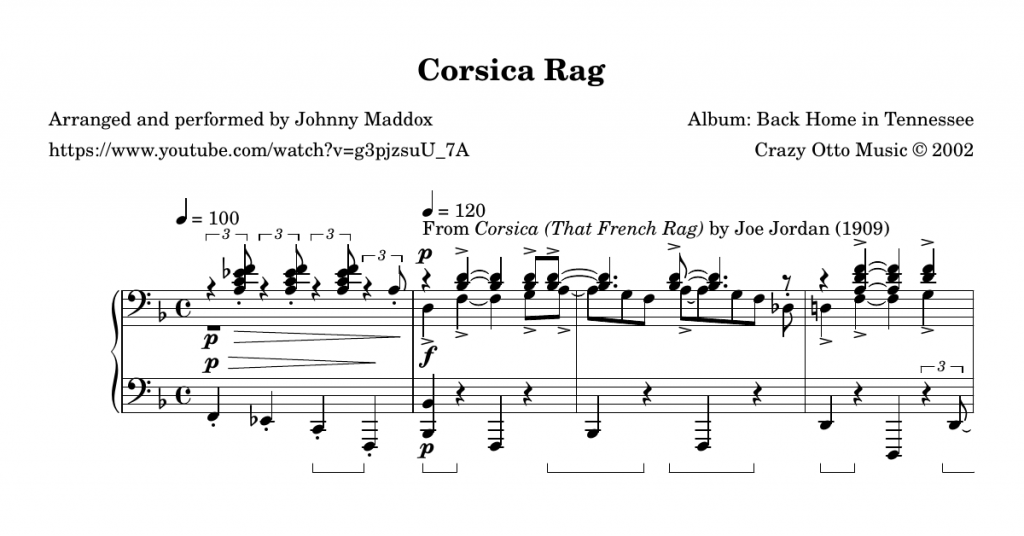Joe Jordan composed Corsica (That French Rag) in 1909. The piece presented here consists of an elaborate arrangement of just the last section of that song, with the addition of a fitting middle section taken from At the Ball, That’s All composed by John Leubrie Hill in 1913 and used in at least one Abbott and Costello production.
The great ragtime artist and music collector Johnny Maddox put together this arrangement, featured on his album Back Home in Tennessee published by Crazy Otto Music in 2002. In recent times, Maddox’s protege Adam Swanson has popularized the piece through repeated public performances of his similar versions.
Maddox’s album has been made available on YouTube by the publisher. I made a complete transcription from that recording, aiming for accuracy in the notes, chords, dynamics and pedaling. While it’s really impossible to achieve 100% accuracy, most ragtime performers couldn’t care less. They like to perform their own renditions that can be anywhere from slightly different to barely recognizable. Those performers have such natural talent they don’t necessarily even need sheet music. They can just listen, recreate and improvise. Personally (and regrettably), I grew up on sheet music and have a total dependence on it, with little natural conception of the harmonic structure that is required to improvise good ad hoc performances. A thorough transcription helps compensate for that. Even if it shows lack of originality, it may also be of academic interest.
The software I used consisted of:
- Transkun: an AI-based standalone program that takes an audio file and outputs a MIDI file. This program has basically no settings. The results are pretty raw, missing a lot of notes and adding extra ones. Nevertheless, it is the state of the art and gives by far the best results out of many programs that purport to do this. Notably, it even includes pedal information in the MIDI file.
- Cakewalk by BandLab: used to visualize the MIDI file as notes on a piano staff. The location of measure markers can be adjusted and lined up with the notes. What one sees is very rough and can’t be used directly, but is useful in rapidly discerning notes and chords to generate a first draft.
- Transcribe!: shows a decomposition of the frequency spectrum as well as guessed notes. This software is crucial because it allows one to listen to small sections in a loop at much slower tempos. One can play a piano along side of it to try to match and suss out the chords. When the tempo is changed, the note frequencies are maintained. Notes can also be shifted up or down up to an octave if that helps hear the lowest and highest notes better. I also shifted the recording up by +30 cents into 440 because it was slightly flat.
- LilyPond: the music typesetting software that is the most powerful, but also probably the most tedious. Music is written in a programming language rather than a GUI. Arbitrarily fancy things can be represented, depending on how much work one is willing to go to. Much time is taken entering note names one by one, keeping track of where you are the music, doing test renderings and making endless corrections.
Eighth notes are swung in many places in this piece. I’ve written out swing explicitly in triplets, but in the recording, Maddox varies the extent of the swing so that it is weaker or stronger than actual triplets.
Here is the original recording:
LilyPond has the ability to create multiple scores from one input file. When Corsica_Rag.ly is compiled, it produces three PDF output files as follows:
- Regular version, a conventional score 6 pages long with two staves and all of the dynamic markings. There are two voices in the right hand, where each voice has its own dynamics.
2. Three-stave version. The music is nearly the same as the regular version, except the main melody voice has been split out into a separate staff. It is 8 pages and may be useful for practicing. I like to play the melody louder and mostly with my thumb.
3. Simplified (no dynamics) version. The music is condensed onto 4 pages. All of the dynamics and pedaling are stripped out and left to the performer.
Here is a MIDI file for download, and also a primitive on-line MIDI player for instant gratification.
